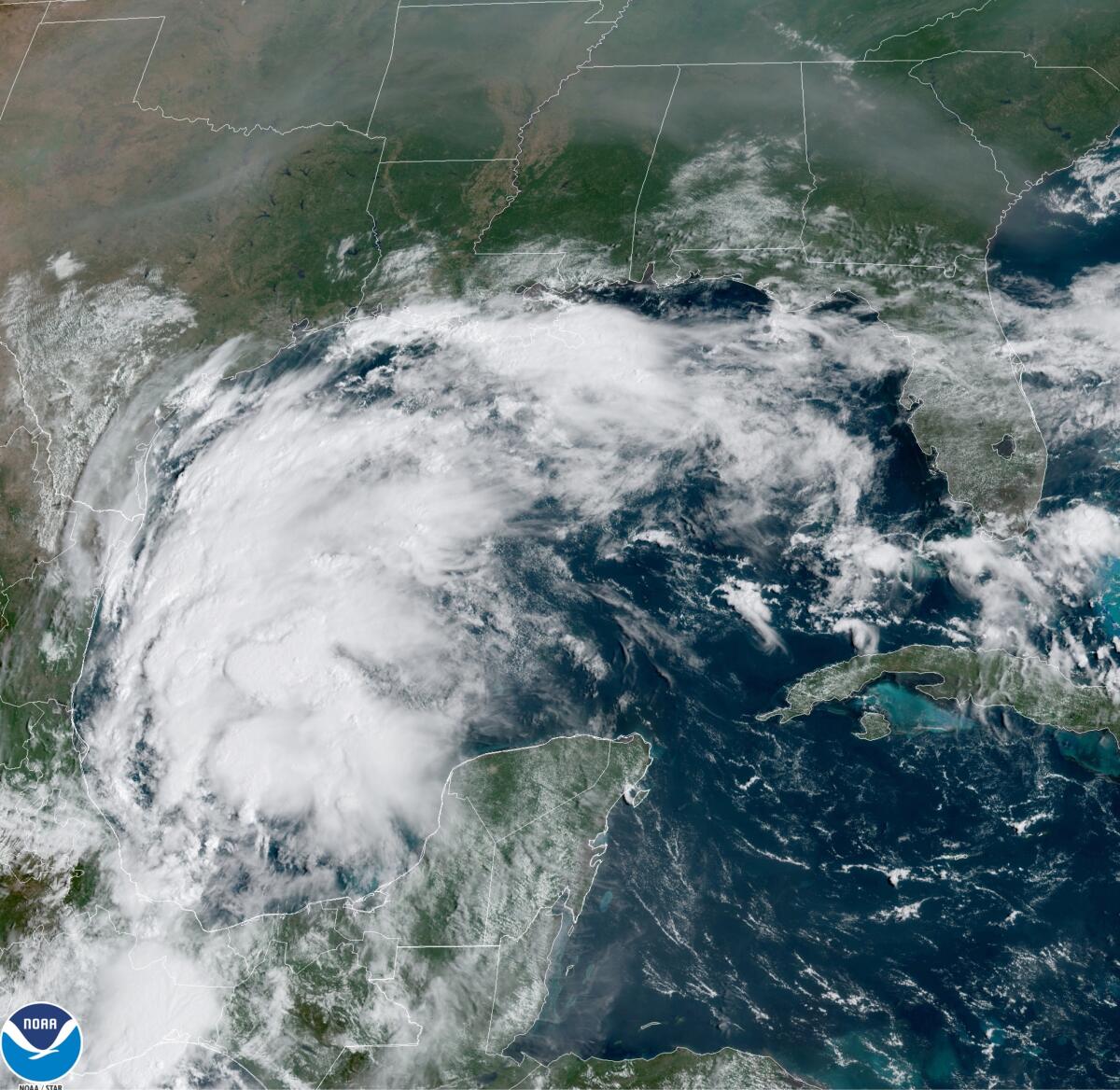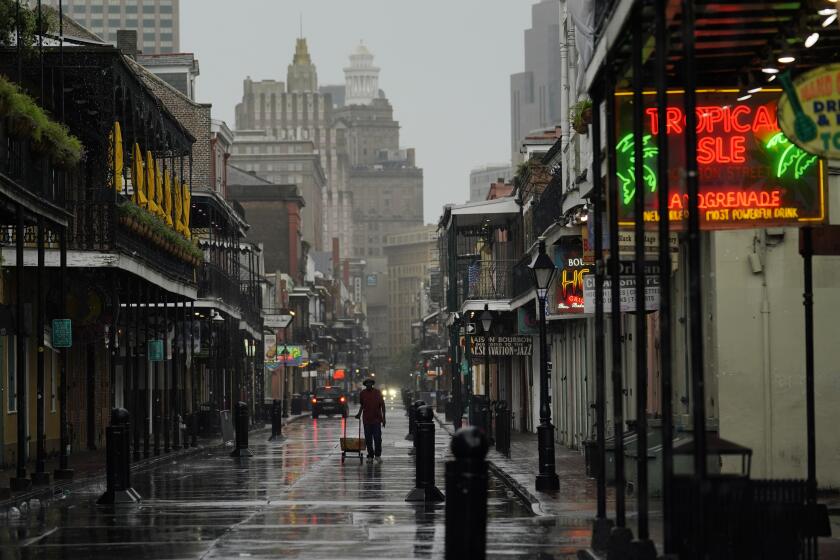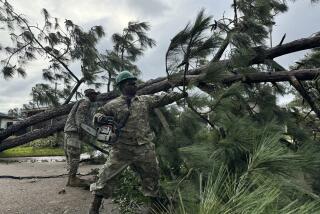Tropical Storm Nicholas threatens to hit Texas as a hurricane

- Share via
HOUSTON — Tropical Storm Nicholas gathered strength Monday and threatened to blow ashore in Texas as a hurricane that could bring up to 20 inches of rain to parts of the Gulf Coast, including the same area hit by Hurricane Harvey in 2017 and storm-battered Louisiana.
Although the system was expected to generate only a fraction as much rain as Harvey, nearly all of the Texas coastline was under a tropical storm warning that included potential flash floods and urban flooding. Gov. Greg Abbott said authorities had placed rescue teams and resources in the Houston area and along the coast.
Forecasters at the National Hurricane Center in Miami said the system’s top sustained winds were 70 mph, nearly hurricane strength and an increase of 10 mph from earlier in the day. If the winds hit 74 mph, the storm becomes a Category 1 hurricane. It was moving north-northeast at 12 mph and was predicted to make landfall late Monday night along the central Texas coast.
An automated station in Matagorda Bay registered a sustained wind of 55 mph with a gust of 71 mph, the hurricane center reported.
In flood-prone Houston, officials worried that heavy rain late Monday and early Tuesday could inundate streets and flood homes. Authorities deployed high-water rescue vehicles throughout the city and erected barricades at more than 40 locations that tend to flood, Mayor Sylvester Turner said.
“This city is very resilient. We know what we need to do. We know about preparing,” said Turner, referencing four major flood events that have hit the Houston area in recent years, including devastating damage from Harvey, which flooded more than 150,000 homes.
New Orleans is showing signs of making a comeback nearly two weeks after Hurricane Ida blasted coastal Louisiana.
Turner and Harris County Judge Lina Hidalgo asked residents to stay off the roads Monday evening to avoid risking their lives or the lives of first responders who might be called to rescue them from flooded areas.
“What I need each resident to do is get where you need to be by 6 p.m. and stay there,” said Hidalgo, the top elected official in Harris County, which includes Houston.
The Houston school district, the state’s largest, announced that classes would be canceled Tuesday because of the storm. The weather threat also closed COVID-19 testing and vaccination sites in the Houston and Corpus Christi areas and forced the cancellation of a Harry Styles concert scheduled for Monday evening in Houston.
A strengthening Hurricane Ida, bearing high winds and the likelihood of flooding rain as it heads for the Louisiana coast, could damage the energy-heavy Gulf Coast economy and potentially have economic consequences well beyond the region.
At dusk Monday, Nicholas was centered roughly 35 miles south-southwest of Matagorda, Texas, and a hurricane watch was issued from Port Aransas to San Luis Pass.
Six to 12 inches of rain were expected along the middle and upper Texas coast, with isolated maximum amounts of 18 inches possible. Other parts of southeast Texas and south-central Louisiana and southern Mississippi could see four to eight inches in the coming days.
“Listen to local weather alerts and heed local advisories about the right and safe thing to do, and you’ll make it through this storm, just like you’ve had many other storms,” Abbott said during a news conference in Houston.
Toward a more sustainable California
Get Boiling Point, our newsletter exploring climate change, energy and the environment, and become part of the conversation — and the solution.
You may occasionally receive promotional content from the Los Angeles Times.
Nicholas was headed toward the same area of Texas that was hit hard by Harvey, which stalled for four days after reaching land, dropping more than 60 inches of rain in the southeastern part of the state. Harvey was blamed for at least 68 deaths, including 36 in the Houston area.
After Harvey, voters approved the issuance of $2.5 billion in bonds to fund flood-control projects, including the widening of bayous. The 181 projects designed to mitigate damage from future storms are at various stages of completion.
University of Miami hurricane researcher Brian McNoldy said he expects Nicholas to be “magnitudes less than Harvey in every regard.”
The main worry with Nicholas is its speed. Storms are moving slower than they used to, said hurricane researcher Jim Kossin of the Climate Service, and Nicholas could get stuck between two other weather systems.
Louisiana Gov. John Bel Edwards declared a state of emergency Sunday night, ahead of the storm’s arrival. The state is still recovering from Hurricane Ida and last year’s Hurricane Laura and historic flooding. The system was expected to bring the heaviest rainfall west of where Ida slammed into Louisiana two weeks ago.
Across Louisiana, almost 120,000 customers remained without power Monday morning, according to the utility tracking site poweroutage.us.
As a ferocious hurricane bears down on South Florida, water managers desperately lower canals in anticipation of 4 feet of rain.
In Cameron Parish in coastal Louisiana, Scott Trahan is still finishing repairs after Laura put about two feet of water into his home last year. He hopes to be finished by Christmas. He said many in his area have moved instead of rebuilding.
“If you get your butt whipped about four times, you are not going to get back up again. You are going to go somewhere else,” Trahan said.
Colorado State University hurricane researcher Phil Klotzbach said via Twitter that Nicholas is the 14th named storm of the 2021 Atlantic hurricane season. Only four other years since 1966 have had 14 or more named storms by Sept. 12: 2005, 2011, 2012 and 2020.
Associated Press writers Jill Bleed in Little Rock, Arkansas, and Seth Borenstein in Washington contributed to this report.
More to Read
Sign up for Essential California
The most important California stories and recommendations in your inbox every morning.
You may occasionally receive promotional content from the Los Angeles Times.












